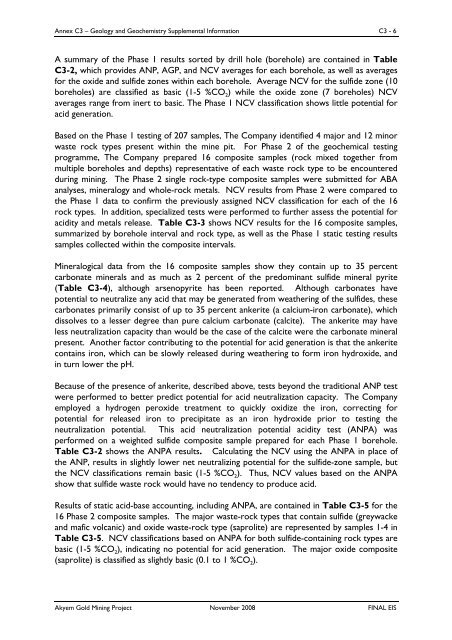annexc - Newmont Mining Corporation
annexc - Newmont Mining Corporation
annexc - Newmont Mining Corporation
Create successful ePaper yourself
Turn your PDF publications into a flip-book with our unique Google optimized e-Paper software.
Annex C3 – Geology and Geochemistry Supplemental Information C3 - 6<br />
A summary of the Phase 1 results sorted by drill hole (borehole) are contained in Table<br />
C3-2, which provides ANP, AGP, and NCV averages for each borehole, as well as averages<br />
for the oxide and sulfide zones within each borehole. Average NCV for the sulfide zone (10<br />
boreholes) are classified as basic (1-5 %CO 2) while the oxide zone (7 boreholes) NCV<br />
averages range from inert to basic. The Phase 1 NCV classification shows little potential for<br />
acid generation.<br />
Based on the Phase 1 testing of 207 samples, The Company identified 4 major and 12 minor<br />
waste rock types present within the mine pit. For Phase 2 of the geochemical testing<br />
programme, The Company prepared 16 composite samples (rock mixed together from<br />
multiple boreholes and depths) representative of each waste rock type to be encountered<br />
during mining. The Phase 2 single rock-type composite samples were submitted for ABA<br />
analyses, mineralogy and whole-rock metals. NCV results from Phase 2 were compared to<br />
the Phase 1 data to confirm the previously assigned NCV classification for each of the 16<br />
rock types. In addition, specialized tests were performed to further assess the potential for<br />
acidity and metals release. Table C3-3 shows NCV results for the 16 composite samples,<br />
summarized by borehole interval and rock type, as well as the Phase 1 static testing results<br />
samples collected within the composite intervals.<br />
Mineralogical data from the 16 composite samples show they contain up to 35 percent<br />
carbonate minerals and as much as 2 percent of the predominant sulfide mineral pyrite<br />
(Table C3-4), although arsenopyrite has been reported. Although carbonates have<br />
potential to neutralize any acid that may be generated from weathering of the sulfides, these<br />
carbonates primarily consist of up to 35 percent ankerite (a calcium-iron carbonate), which<br />
dissolves to a lesser degree than pure calcium carbonate (calcite). The ankerite may have<br />
less neutralization capacity than would be the case of the calcite were the carbonate mineral<br />
present. Another factor contributing to the potential for acid generation is that the ankerite<br />
contains iron, which can be slowly released during weathering to form iron hydroxide, and<br />
in turn lower the pH.<br />
Because of the presence of ankerite, described above, tests beyond the traditional ANP test<br />
were performed to better predict potential for acid neutralization capacity. The Company<br />
employed a hydrogen peroxide treatment to quickly oxidize the iron, correcting for<br />
potential for released iron to precipitate as an iron hydroxide prior to testing the<br />
neutralization potential. This acid neutralization potential acidity test (ANPA) was<br />
performed on a weighted sulfide composite sample prepared for each Phase 1 borehole.<br />
Table C3-2 shows the ANPA results. Calculating the NCV using the ANPA in place of<br />
the ANP, results in slightly lower net neutralizing potential for the sulfide-zone sample, but<br />
the NCV classifications remain basic (1-5 %CO 2). Thus, NCV values based on the ANPA<br />
show that sulfide waste rock would have no tendency to produce acid.<br />
Results of static acid-base accounting, including ANPA, are contained in Table C3-5 for the<br />
16 Phase 2 composite samples. The major waste-rock types that contain sulfide (greywacke<br />
and mafic volcanic) and oxide waste-rock type (saprolite) are represented by samples 1-4 in<br />
Table C3-5. NCV classifications based on ANPA for both sulfide-containing rock types are<br />
basic (1-5 %CO 2), indicating no potential for acid generation. The major oxide composite<br />
(saprolite) is classified as slightly basic (0.1 to 1 %CO 2).<br />
Akyem Gold <strong>Mining</strong> Project November 2008 FINAL EIS











